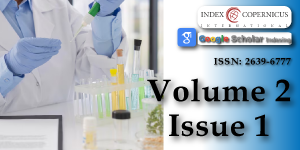Edible vaccines to combat Infectious Bursal Disease of poultry
Main Article Content
Article Details
Copyright (c) 2018 Khan MS.

This work is licensed under a Creative Commons Attribution 4.0 International License.
Farhanah MI, Yasmin AR, Isa NM, Hair-Bejo M, Ideris A, et al. Bursal transcriptome profiling of different inbred chicken lines reveals key differentially expressed genes at 3 days postinfection with very virulent infectious bursal disease virus. Journal of General Virology 2018; 99: 21–35. Ref.: https://goo.gl/odUMze
Economic survey of Pakistan. 2016-17. Ref.: https://goo.gl/A189mb
Khan MS, Khan IA. Biopharming: A Biosecurity Measure to Combat Newcastle Disease for Household Food Security. Biosafety 2015; 4: e156. Ref.: https://goo.gl/SG8rgw
Shabbir MZ, Zohari S, Yaqub T, Nazir J, Shabbir MA, et al. Genetic diversity of Newcastle disease virus in Pakistan: a countrywide perspective. Virol J. 2013; 10: 170. Ref.: https://goo.gl/cMd9zo
Müller H, Mundt E, Eterradossi N, Islam MR. Current status of vaccines against infectious bursal disease. Avian Pathol. 2012; 41: 133-139. Ref.: https://goo.gl/S4uPwc
Mogensen TH. Pathogen recognition and inflammatory signaling in innate immune defenses. Clin Microbial Rev. 2009; 22: 240-273. Ref.: https://goo.gl/A4sp3a
Rehman ZU, Meng C, Umar S, Munir M, Ding C. Interaction of infectious bursal disease virus with the immune system of poultry. World's Poultry Sci J. 2016; 72: 805-820. Ref.: https://goo.gl/m9Rgby
Mundt E. Tissue culture infectivity of different strains of infectious bursal disease virus is determined by distinct amino acids in VP2. J Gen Virol. 1999; 80: 2067-2076. Ref.: https://goo.gl/Xg81XD
Nielsen O. Sørensen P, Hedemand J, Laursen S, Jørgensen PH. Inflammatory response of different chicken lines and B haplotypes to infection with infectious bursal disease virus. Avian Pathol. 1998; 27: 181-189. Ref.: https://goo.gl/BDEhL5
Muller H, Scholtissek C, Becht H. The genome of infectious bursal disease virus consists of two segments of double-stranded RNA. J Virol. 1979; 31: 584-589. Ref.:
Ture O, Saif Y, Jackwood D. Restriction fragment length polymorphism analysis of highly virulent strains of infectious bursal disease viruses from Holland, Turkey, and Taiwan. Avian Dis. 1998; 42: 470-479. Ref.: https://goo.gl/X2QFdX
Brown MD, Green P, Skinner MA. VP2 sequences of recent European ‘very virulent’ isolates of infectious bursal disease virus are closely related to each other but are distinct from those of ’classical’ strains. J Gen Virol 1994; 75: 675–680. Ref.: https://goo.gl/Qu2qxF
Teshome M, Fentahunand T, Admassu B. Infectious bursal disease (Gumboro disease) in chickens. Br J Poult Sci 2015; 4: 22–28. Ref.: https://goo.gl/icaJr2
Alkie TN, Rautenschlein S. Infectious bursal disease virus in poultry: Current status and future prospects. Vet Med Res Rep 2016; 7: 9-18. Ref.: https://goo.gl/S9iJrA
Lukert PD, Saif YM. Infectious bursal disease. In: Saif Y. M. (Ed.) Diseases of Poultry (11th ed.). Iowa State University Press, Ames, Iowa. 2003; 161-179.
Rosenberger JK, Cloud SS, Gelb J, Odor E, Dohms SE. Sentinel birds survey of Delmarva broiler flocks. Proc. of the 20th National Meeting on Poultry Health and Condemnation. Ocean City, MD, US. 1985; 94-101.
Chettle N, Stuart JC, Wyeth PJ. Outbreak of virulent infectious bursal disease in East Anglia. Vet Rec 1989; 125: 271-272. Ref.: https://goo.gl/s15kYj
Miller PJ, Estevez C, Yu Q, Suarez DL, King DJ. Comparison of viral shedding following vaccination with inactivated and live Newcastle disease vaccines formulated with wild-type and recombinant viruses. Avian Dis. 2009; 53: 39-49. Ref.: https://goo.gl/kNnjS2
Khan MS, Maliga P. Fluorescent antibiotic resistance marker to track plastid transformation in higher plants. Nature Biotechnol.1999; 17: 910-915. Ref.: https://goo.gl/dqvyUL
Khan MS, Hameed MW, Nozoi M, Shiina T. Disruption of the psbA gene by copy correction mechanism reveals that the expression of plastid-encoded genes is regulated by photosynthesis activity. J Plant Res. 2007; 120: 421-430. Ref.: https://goo.gl/eSjnDy
Khan MS. Hybrid transcription-mediated transgene regulation in plastids. Trends in Biotechnol. 2006; 24: 479-482. Ref.: https://goo.gl/DeFDcv
Bock R, Khan MS. Taming plastids for a green future. Trends in Biotechnol. 2004; 22: 311-318. Ref.: https://goo.gl/kKU3B3
Suzuki K, Nakanishi H, Bower J, Yoder DW, Osteryoung KW, et al. Plastid chaperonin proteins Cpn60 alpha and Cpn60 beta are required for plastid division in Arabidopsis thaliana. BMC Plant Biol. 2009; 9: 38. Ref.: https://goo.gl/BhKFJe
Daniell H, Khan MS, Allison L. Milestones in chloroplast genetic engineering: an environmentally friendly era in biotechnology. Trends in Plant Sci. 2002; 7: 84-91. Ref.: https://goo.gl/biyvjQ
Khan MS. Utilizing heterologous promoters to express green fluorescent protein from jellyfish in tobacco chloroplasts. Pak J Bot. 2001; 33: 43-52. Ref.: https://goo.gl/oqLF5B
Wu H, Singh NK, Locy RD, Gunn KS, Giambrone JJ. Immunization of Chickens with VP2 Protein of Infectious Bursal Disease Virus Expressed in Arabidopsis thaliana. Avian Dis. 2004; 48: 663 – 668. Ref.: https://goo.gl/S5EYPQ
Wu J, Yu L, Li L, Hu J, Zhou J, Zhou X. Oral immunization with transgenic rice seeds expressing VP2 protein of infectious bursal disease virus induces protective immune responses in chickens. Plant Biotechnol J. 2007; 5: 570 – 578. Ref.: https://goo.gl/3REyng

